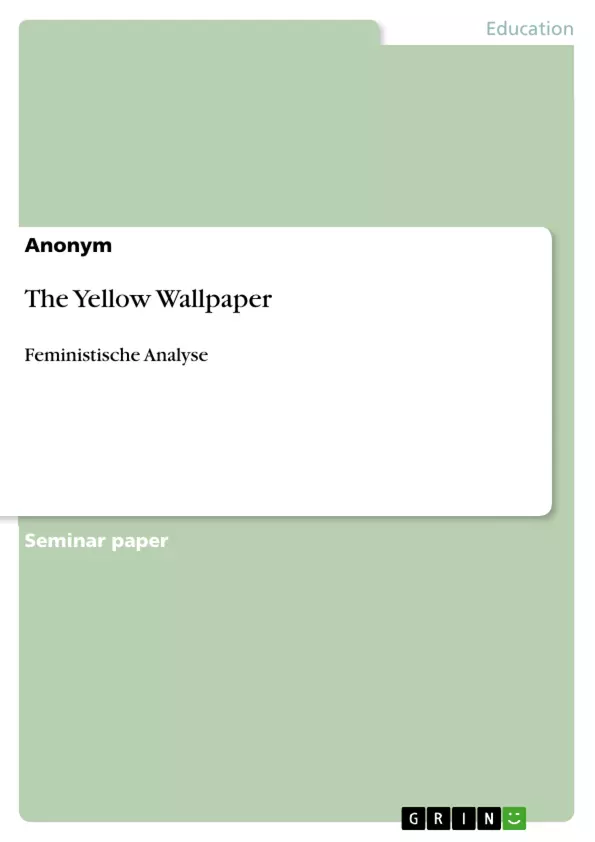The short story The Yellow Wallpaper by Charlotte Perkins Gilman was published in 1892 and is considered to be a very important work of feminist literature. In this paper the short story will be analyzed in regard to the critical theory of feminism. The main part will give special attention to stereotypes of women represented in the story, namely the perfect housewife and the hysterical woman, as well as the traditional gender power structure in the late nineteenth century. However, at the beginning there will be a brief explanation of the aspects of feminism as a critical literary theory. The following part will pay close attention to symbols like the bedroom to demonstrate how they reflect the social and emotional state of the narrator and what they reveal about her defeat or liberation. Additionally, it will illustrate the main characters of the short story, specifically the unknown narrator herself, and which stereotypes of people from the Victorian era they represent. The narrator tells the reader about her life as a wife and mother. She has great problems in fulfilling her duty as a mother because of depression since the birth of her child. The narrator and her husband stay in an old mansion house so that she can recover, but her husband does not really think that she is sick. He leaves her alone almost every day, supposedly because of his work, but this emotional loneliness and the absent of her family and friends, lead her to break down at the end of the story. But is the short story The Yellow Wallpaper really about depression or does it actually reveal something about the woman`s role in society in the late nineteenth century?
Inhaltsverzeichnis (Table of Contents)
- Introduction
- Feminism as literary criticism
- The Yellow Wall-Paper
- Images of women
- The perfect housewife
- The hysterical woman
- Symbols
- Garden
- House
- Bedroom
- Windows
- Wallpaper
- Images of women
- Conclusion
Zielsetzung und Themenschwerpunkte (Objectives and Key Themes)
This paper analyzes Charlotte Perkins Gilman's short story "The Yellow Wallpaper" through the lens of feminist literary criticism. It explores the story's portrayal of women in the late nineteenth century, focusing on the stereotypes of the perfect housewife and the hysterical woman. The analysis examines symbols such as the bedroom, revealing their connection to the narrator's social and emotional state, and uncovering insights into her potential defeat or liberation. The paper ultimately questions whether the story is primarily about depression or a commentary on women's roles in society during this period.
- Feminist literary criticism and its application to "The Yellow Wallpaper"
- Stereotypes of women in the late nineteenth century, including the perfect housewife and the hysterical woman
- The role of symbolism in the story, particularly the bedroom, and its connection to the narrator's state of mind
- The portrayal of the narrator and the Victorian era stereotypes she represents
- The story's exploration of the potential relationship between depression and women's societal roles
Zusammenfassung der Kapitel (Chapter Summaries)
- Introduction: The introduction sets the context for the analysis, highlighting the importance of "The Yellow Wallpaper" as a feminist work. It outlines the paper's focus on analyzing the story through a feminist lens, examining stereotypes of women and the social power dynamics of the late nineteenth century. The introduction also introduces the key symbols within the story, such as the bedroom, and hints at the possibility of a broader commentary on women's roles in society.
- Feminist Literary Criticism: This chapter delves into the theoretical framework of feminist criticism, explaining its core principles and identifying different phases of feminist thought. It discusses how feminist criticism analyzes literature to understand the portrayal and potential oppression of women. The chapter mentions key figures like Virginia Woolf and Elaine Showalter, highlighting their contributions to feminist literary criticism.
- The Yellow Wallpaper: This chapter begins the in-depth analysis of the story, exploring the representations of women. It focuses on the "perfect housewife" stereotype, drawing connections to the expectations placed upon women in the context of the growing American industrialization. The chapter also examines the portrayal of the "hysterical woman," providing context for the portrayal of the narrator's mental state.
Schlüsselwörter (Keywords)
This preview focuses on the themes of feminist literary criticism, the portrayal of women in the late nineteenth century, the "perfect housewife" and "hysterical woman" stereotypes, the symbolism in the story, particularly the bedroom, and the potential connections between depression and women's roles in society. The main keywords include: feminism, literary criticism, "The Yellow Wallpaper", Charlotte Perkins Gilman, women's roles, Victorian era, stereotypes, symbolism, bedroom, depression.
- Citation du texte
- Anonym (Auteur), 2009, The Yellow Wallpaper, Munich, GRIN Verlag, https://www.grin.com/document/196323



